Minimizing uncertainty: Geosteering advances keep wellbores in sweet spot
By Katie Mazerov, contributing editor
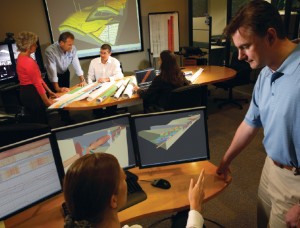
Deviated, ultra-deep and unconventional have become bywords of the complex and complicated nature of oil and gas drilling today. Underlying this new vernacular is another challenge that the industry is striving to conquer as it pushes into increasingly unknown and unstable environments: uncertainty. But in the ever-changing age of technology, advances in geosteering are taking oil and gas recovery to a more certain future.
Sophisticated geosteering technology is giving operators and drilling contractors more precise real-time information to help them optimize the placement of a wellbore in the reservoir in order to achieve maximum production. New technologies tell them how to steer the drill bit to stay in the target zone. They also let them better visualize not only where they’ve been but, more importantly, where they need to go.
One drilling engineer uses an Oreo cookie to describe the process: Stay in the cream, or the sweet spot, without hitting the cookies above and below.
What began 15 years ago as a technology that relied primarily on imprecise, low-resolution seismic data to land a well has evolved to include a sophisticated array of fit-for-purpose instruments. Some instruments, including gamma ray, explore the zone adjacent to the wellbore. Others launch deep-reading electromagnetic waves to image the formation away from the wellbore.
Geosteering experts model the data in real time and update the geological maps of the subsurface and the well location as it relates to geological events and boundaries. The new sensors are opening up possibilities in environments that 10 years ago were deemed to be not economically viable, from complicated and thin reservoirs to mature fields that are being tapped for production once again.
And yes, there is an app for that. The real-time data is being transmitted not just to computers and laptops, but on smartphones and other mobile devices.
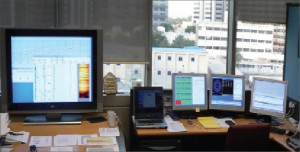
“Geosteering is the outgrowth of measurement while drilling (MWD) and logging while drilling (LWD) technologies that helped advance horizontal drilling. The information we used to get with wireline after we drilled a well, we now receive in real time with LWD,” said Frank Jreij, an engineer, partner and marketing manager of GeoSteering LLC, a Houston company that provides real-time geosteering services for oil and gas operators and MWD/LWD firms worldwide.
“We are their eyes and compass downhole,” Mr Jreij said. ”By processing the real-time data coming from downhole, we can determine if the formation dip has changed. We then pass that information to the geologist and the directional driller so they can follow the new dip we have just computed and have a better chance of staying in the pay zone.
“Staying in the zone is the most important thing an operator wants to do for maximum production because formations can vary and bend up and down,” he continued. “If a horizontal well is being drilled at 90° and the zone changes from being flat to going up one degree, we advise the directional driller to drill at 91°. If he stays at 90°, he will keep going down-structure and risk losing 400 to 500 feet by exiting at the base of the target zone.”
With its in-house RigComms software, the firm can process any type of LWD data – gamma ray, resistivity, nuclear, sonic – choosing the application that is best suited for a particular reservoir. For example, some shale-gas wells in the US can be geosteered using the more basic gamma ray technology, while wells in the Bakken oil shale play typically require resistivity tools as well in order to be geosteered properly.
Extended-reach wells with more complicated geology, such as those in the North Sea and the Middle East, require more upfront planning and modeling, more examination of field data, structural geology, seismic data and any offset wells around them that have been logged, Mr Jreij explained.
The 24/7 geosteering process begins at the kick-off point, when the well starts to go directional, all the way to the end of the lateral. “Landing is extremely important,” he continued. “We geosteer the landing curve so directional drillers can land the well at the right place. Then we help them geosteer the lateral while they’re drilling horizontally to help them stay in the zone and maximize production. We are monitoring every foot that is drilled on our computers in real time, logging the data in our database and processing it to geosteer the well within the target zone for our clients.”
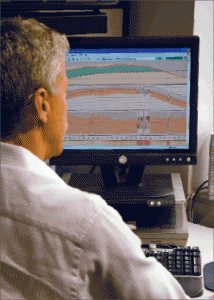
The term geosteering first appeared in the early 1990s as horizontal wellbore drilling expanded offshore, initially in the North Sea and the Gulf of Mexico, said Jon Skillings, business development product manager, Reservoir Navigation Services, Baker Hughes. “In these early days, this real-time information was largely limited to cuttings analysis and perhaps LWD gamma ray data, which was used to correlate known marker formations,” he said. “Success was often limited, and depended on the availability of offset well information to reduce particularly depth uncertainties commonly associated with seismic information.”
“The first big breakthrough in the ability to successfully land a horizontal well optimally in the target horizon, then maintain the well in the zone of maximum interest while predicting and avoiding the reservoir exit, occurred in the mid-1990s,” Mr Skillings continued. Steerable systems were introduced, incorporating near-bit LWD formation evaluation sensor arrays combined with near-bit inclination control.
“Near-bit, multiple depth-of-investigation propagation resistivity measurements allowed the detection of conductive boundaries – a shale roof above the well path or a water zone below – up to 17 feet above or below the well path,” he said. “These measurements were complemented by shallow reading (gamma ray and density) sectored or azimuthal information, allowing estimations of formation dip in real time. Combining this real-time information with advances in interactive geosteering interpretation software made it possible to track boundaries above and below the well path, predict ahead of the bit and make trajectory changes in real time to keep the wellbore in the zone of maximum interest.”
The introduction of rotary steerable systems in the late 1990s made it possible to push horizontal drilling to new limits, and complex extended-reach drilling, multilateral and 3D designer wells became more commonplace. “The philosophy of placing multiple depth-of-investigation sensors close to the bit prevailed, along with new advances in real-time, high-resolution, high-definition borehole imaging,” Mr Skillings said. “It was now no longer necessary to follow geometric well plans when drilling horizontal wells. Real-time data could be interpreted quickly, allowing proactive decision-making on wellbore trajectory to truly navigate the reservoir.
“While deep-reading propagation resistivity sensors could detect conductive boundaries some distance from the wellbore, the measurements were omni-directional, measuring all directions out into the formation,” he said. “But in complex scenarios, it was sometimes difficult to determine whether a boundary was located above or below the well path. Imaging devices give direction, but they are shallow-reading measurements.”
About five years ago, that conundrum was solved with the introduction of deep-reading azimuthal propagation resistivity measurements. “Now, instead of getting an omni-directional return, we have a signal that can tell us precisely where the boundaries are – above, below, left or right,” Mr Skillings said.
That advancement is key to Baker Hughes’ AziTrak deep azimuthal resistivity system, which has been deployed worldwide. In the US, Warren Resources is using the technology to recover bypassed oil in the Wilmington Reservoir in Los Angeles County, a field discovered in 1932, Mr Skillings said. The mature oil-over-water reservoir required wells to be placed high in the pay zone to avoid water encroachment and maximize production. The deep azimuthal resistivity system allows wells to be steered close to the shale roof, accessing attic oil for 1,400-ft and 1,800-ft horizontal section lengths. This has been instrumental in enhancing production from wells that otherwise would not have been economically viable.
“As wells become increasingly complex – as in the case of wells designed to access bypassed reserves in conventional reservoirs or to tap reserves in deepwater turbidite environments – the key to lateral placement is the ability to detect remote boundaries in real time; update the models that describe and predict the environment ahead of the bit; and then to make proactive decisions to keep the well in the most productive zone,” Mr Skillings said.
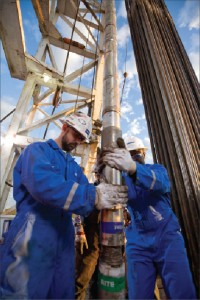
PeriScope real-time bed boundary mapping, Schlumberger’s deep-reading, proactive geosteering technology developed in 2005, has been deployed in oilfields worldwide to address conductivity contrast between bed boundaries in very thin reservoirs or reservoirs with a thin pay zone, and where the geology is complicated, said Mike Williams, vice president of sales, Schlumberger Drilling and Measurements.
Depending on the nature of the rock, the tool can see 20 ft or more out from the wellbore. “Before we get near the boundary, we can see it and optimize the well path in the most efficient way possible and stay in the sweet spot more accurately than we could before,” Mr Williams said. “If the geology changes, we can proactively see it changing before we cross it and adjust accordingly.”
The technology has been deployed in a long horizontal well in the North Sea that has a 190° azimuth turn and build from 4.91° to 90°, with long doglegs through unstable, faulted formations. The PeriScope bed boundary mapper geosteered the horizontal section of the wellbore in the sweet spot and mapped the roof of the reservoir, achieving improved reservoir contact with more than 3,700 ft penetrated.
As with most technologies, operators must weigh the investment against the benefit. “For a reservoir that is 300 feet deep and production is the same no matter where you are, tools such as this bring little or no value,” Mr Williams noted. “But for a reservoir that is 10 feet deep, with a sweet spot that is exactly three feet from the cap rock, it is very valuable.”
The PeriScope service proved valuable in placing two horizontal re-entry wells in target sands in Bohai Bay, China, where water had encroached and oil production had declined. The mature field was challenging due to uncertainty about the thickness of overlying shale, inconsistent markers and sedimentary facies with significant lateral changes. The re-entry wells were landed and geosteered successfully, resulting in a 50% increase in oil production.
MWD services that provide high transmission rates are a critical component of geosteering technology. “The data have little worth if they’re not delivered in real time,” Mr Williams said. “We need to transmit data as fast as we can to maximize the decision time. That’s relatively easy to do in shallow depths. But the deeper we go, with today’s long horizontal and extended-reach wells or ultra-deep offshore wells, that transmission starts to become a challenge.” Issues that may affect transmission rate include measured depth; high mud weights, as seen in the Gulf of Mexico, for example, due to pressures that affect the signal; the physical constraints of the wellbore and how long it is; the drilling conditions and mud and pump rates.
There are efforts under way to push deep-reading technology to see up to 100 ft and up to five or six boundaries, advancements that could present new challenges in data transmission and analysis. “If we provide that much more data, we run the risk of people experiencing data paralysis because of the time it takes to process all the information,” Mr Williams said. “So there is a big need for smart applications that separate the wheat from the chaff and point the experts to the information that is important so they can make the proper decisions in a time-effective way.”
Halliburton’s InSite ADR (Azimuthal Deep Resistivity) sensor, on the market for four years, is being used successfully in conventional reservoirs, which still produce more than 80% of the world’s oil and gas resources, said Roland Chemali, chief petrophysicist for Halliburton’s Sperry Drilling business line. Data is transmitted in real time and can be accessed on all major smartphone devices and even the iPad.
“With this tool we can detect the low-resistivity, non-productive zones surrounding the hydrocarbon-rich formation before we hit them and correct the path,” he said. “In thinner pay zones or where we’re trying to place a well up against a water barrier or cap rock, this technology is critical in our being able to map those boundaries and place the wellbore precisely where we want it for achieving maximum production.”
The technology has been successful in traditional reservoirs, including sandstones and carbonates; in heavy oil, where the wellbore needs to be placed a certain distance from a shale or water boundary; and in coalbed methane, where an operator needs to stay in a fairly thick coal seam, said Jason Pitcher, global wellbore placement solutions champion, Halliburton.
The sensor also has been deployed for some shale applications, such as the Bakken. “In that case, the tool has been extremely effective in placing the well in the limestone sequence of the Middle Bakken. We put a wellbore into the carbonate sequence in the Middle Bakken and then stimulate into the Upper and Lower Bakken, which are rich in oil,” Mr Pitcher said
“Operators also are using this tool for mapping, to define reservoir thickness,” he continued. “That gives tremendous value. If we know how thick the reservoir is, we can make our reserve calculations more exact and we can get a better handle on reserve estimates because we can distinguish the top from the bottom.”
Pioneer Natural Resources is using the InSite ADR sensor technology to plan and geosteer horizontal oil wells off the North Slope of Alaska. The conventional reservoir is located in the Kuparuk sand at Oooguruk Island, in a remote, harsh Arctic environment, and is relatively thin and faulted. The payzone is bounded by unstable shale layers above and below.
“In these particular sands, the thickness and the variability of the thickness, combined with the structural complexity of the well, make well placement and drilling challenging,” said Robert Cook, geoscience manager for Pioneer. “By knowing the resistivity properties within the reservoir and the surrounding rocks, we’re able to image the resistivity boundaries at various distances from and in azimuth around the wellbore to get a picture, while drilling, of where the boundaries are relative to the drill bit.”
Paul Daggett, operations geologist for Pioneer, noted that “in the past, drilling a reservoir that was 10 or 15 feet thick and staying in the zone without having to sidetrack two or three times was very difficult.” He explained that the “look-ahead” technology uses specialized drill collars containing a series of electromagnetic sensors, each of which has a geosignal, that looks up, down, left and right.
“By looking at the ratios of opposite responses from those signals, we can gain a better understanding of where the boundaries are,” Mr Daggett said. “We can see the differences between what the up- and down-looking sensors are seeing. In the past, if we had come upon a boundary, we would have had to drill through it, then log it afterwards.” The new, advanced tools also record a large amount of data and keep it in memory for processing at the surface in a post-well evaluation for a more detailed log analysis for formation evaluation.
The technology has been the key to Pioneer’s development of the reservoir that otherwise may have been economically marginal at best. “The operational costs here are high because of the harsh Arctic environment and the fact that access to the drill site is quite limited,” Mr Cook said. “For much of the year, we can only get to the site by helicopter or boat. This tool has allowed us to drill more accurately, to maximize the wellbore recovery and thus minimize the cost. And in this day and age, the business is all about margins and cost benefit.”
While proactive deep-reading azimuthal technologies are being deployed successfully for horizontal drilling in thin, mature and complex conventional reservoirs, they are not suited to unconventional shale gas plays, which typically are homo eneous and don’t feature conductive boundaries or contrasts. Gamma ray tools, such as spectral gamma ray, and sometimes resistivity instruments, are being used in shales to examine clay content, among other things. MWD-gamma ray tools have been effective in places like the Williston Basin in North Dakota, where an oil-rich middle dolomite layer is bounded by layers of shale above and below.
And while service companies are leading the way in advancing geosteering technology, others in the industry are getting into the game.
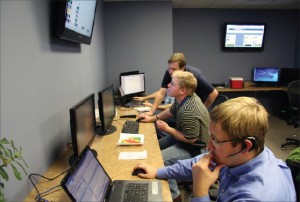
The National Geosteering Operations Center in Tulsa, operated by Horizon Well Logging, uses real-time gamma ray technology to service US land operations in several regions, including the Marcellus, Bakken and Eagle Ford shale plays and the Niobrara Chalk. Opened in November, the center evolved out of the company’s mud logging business, said Horizon president Gino DeMarco.
“We established what we believe is a center of excellence, bringing together a critical mass of resources in a single location,” Mr DeMarco explained. “We can operate in a quality-assurance environment that allows us to have multiple people in one facility, looking at wells all over the country.”
Last year, the company hired 170 geologists and placed them in a field geology development program that includes a two-week rotation at the center for immersion training. In the past year, Horizon has moved from an exclusive focus on unconventional shale gas to one that is close to 60% unconventional liquids.
Mr DeMarco believes Internet-based communication has helped advance the industry’s embrace of geosteering. Horizon Anywhere is a mobile phone app that allows the company’s mud logging customers to view text and data in real time on their cell phones and laptop computers.
This year, at an upcoming American Association of Petroleum Geologists convention, Horizon plans to introduce an expansion of that service that will provide a real-time geosteering graphic interface that can be run on smartphones and tablets. “With geosteering, it’s all about the graphics,” Mr DeMarco said. “What does the formation look like, and where is the wellbore in that formation? This will allow the customer and the people at the well site to see, graphically and in real time, what the geosteerer at the center is seeing. We can all be on the same work surface.”
But the real advances in geosteering will come when the industry becomes more standardized and focused on the business aspects of geosteering, with the various tools working in concert, Mr DeMarco believes. “It’s not how many feet we drill, it’s how many feet we drill in the target,” he said. “It’s not about drilling faster, it’s about looking to get the most target hole we can per day.”
PeriScope is a mark of Schlumberger. AziTrak is a trademarked term of Baker Hughes. InSite ADR is a trademarked term of Halliburton.
Click below for an animation demonstrating the capabilities of Halliburton’s InSite ADR sensor.






AJ Lucas are likely to be moved on the Australian Stock Exchange and are doeomd. Coal Seam gas drilling has been slowed down significantly due to the refusal of farmers to allow CSG company hired drillers onto their land in the rich North West News South Wales farming country which contains the iconic Liverpool Plains. The corrupt links between the previous government and mining companies in issue of mining licences are being exposed in the current Independent Commission against Corruption enquiry. The current government is being advised by the same bureaucrats that are implicated in the current ICAC enquiry. For those familiar with OZ history it has been described as bigger than the Rum Rebellion. CSG is increasingly being seen as a dud with high fugitivbe emissions, massive externalities and no proven technology.